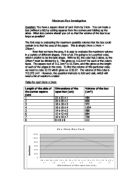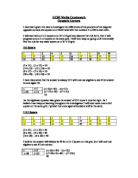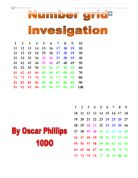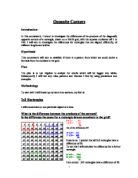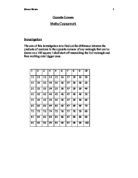Investigation 1-Square shaped pieces of card
Investigation 1-Square shaped pieces of card Aim- To find the length of the cut-out corners that gives the maximum volume for the open box formed by any sized piece of square card. The length of the cut out will be given to three significant figures of accuracy. Method- I will investigate what length of cut-out corners will give the largest volume of square pieces of card with dimensions of 12x12, 18x18, 24x24 and 30x30. Note- When "length", "breadth" and "height" are mentioned, they refer to the dimensions of an open box. When "volume" is mentioned, it refers to the volume of an open box. Height is also the same as to the size of the cut-out corners of an open box. I am going to begin by investigating a square with a side length of 12 cm. Using this side length, the maximum whole number I can cut off each corner is 5cm, as otherwise I would not have any box left. I am going to begin by looking into whole numbers being cut out of the box corners. The formula that needs to be used to get the volume of a box is: Volume = Length * Width * Height If I am to use a square of side length 12cm, then I can calculate the side lengths minus the cut out squares using the following equation. Volume = Length - (2 * Cut Out) * Width - (2 * Cut Out) * Height Using a square, both the length & the width are
Maximum Box Investigation
Maximum Box Investigation Question: You have a square sheet of card 24cm by 24cm. You can make a box (without a lid) by cutting squares from the corners and folding up the sides. What size corners should you cut so that the volume of the box is as large as possible? The first step to evaluating the maximum possible volume that the box could contain is to find the area of the paper. This is simply 24cm x 24cm = 576cm². Now that we have the area, it is easy to evaluate the maximum volume in a variety of different shapes. First of all, I'm going to try a perfect cube, which i predict to be the best shape. With no lid, the cube has 5 sides, so the 576cm² must be divided by 5. This gives us 115.2cm² for each of the cube's faces. The square root of 115.2cm² is 10.73cm, and this gives us the length of each of the edges in the cube. To find the volume of this particular cube, we need to cube 10.73 which gives us 1235.37. The volume of this cube is 715.575 cm³. However, the question instructs to fold and cut, which will need a list of results in a table: Table for card 24cm x 24cm Length of the side of the corner square (cm) Dimensions of the open box (cm) Volume of the box (cm³) 22 x 22 x 1 484 2 20 x 20 x 2 800 3 8 x 18 x 3 972 4 6 x 16 x 4 024 5 4 x 14 x 5 980 6 2 x 12 x 6 864 7 0 x 10 x 7 700 8 8 x 8 x 8 512 Table for card 20cm x 20cm
Number Grid.
I have been given a 10 by 10 grid, with a 2 by 2 box going around numbers 12, 13, 22 and 23, as shown below. I have been asked to find the product of the top right number and the bottom left number in the box (2 by 2 box). Then I was told to do the same with the top left number and the bottom right number. After that I had to calculate the difference between these products. 13 x 22 = 286 _ 12 x 23 = 276 10 By doing this I have decided to investigate further and see what happens with more 2 by 2 squares. 3 by 3 boxes 4 by 4 boxes. 5 by 5 boxes Results: Term (n) 2 3 4 5 Differences in opposite corners 0 0 40 90 60 Term (n)...... 1 2 3 4 5 Differences in Opposite corners...... 0 10 40 90 160 10 30 50 70 20 20 20 We know that the nth term will have to be squared. We know this by the second difference is all the same. Term (n)...... 2 3 4 5 Differences in Opposite corners...... 0 0 40 90 60 Term (n) squared... 4 9 6 25 I have found the rule. nth term squared x ten = n+1. to make it simpler I'll put it in algebraic form, 10(n-1)² I would now like to find out if this will be the same for rectangles. I'm going to start by a 2 by 3 rectangle. 2 by 3 rectangle 2 by 4 rectangle 2 by 5 rectangle I predict that every time I increase the width by one, the difference increases by 10. 2 by 6
Number Stairs Investigation
Number Stairs Investigation 91 92 93 94 95 96 97 98 99 00 81 82 83 84 85 86 87 88 89 90 71 72 73 74 75 76 77 78 79 80 61 62 63 64 65 66 67 68 69 70 51 52 53 54 55 56 57 58 59 60 41 42 43 44 45 46 47 48 49 50 31 32 33 34 35 36 37 38 39 40 21 22 23 24 25 26 27 28 29 30 1 2 3 4 5 6 7 8 9 20 2 3 4 5 6 7 8 9 0 lowest number (n) Long operation Total (t) st Difference (D0) + 2 + 3 + 11 + 12 + 21 50 6 2 2 + 3 + 4 + 12 + 13 + 22 56 6 3 3 + 4 + 5 + 13 + 14 + 23 62 6 4 4 + 5 + 6 + 14 + 15 + 24 68 6 5 5 + 6 + 7 + 15 + 16 + 25 74 6 Judging by this, the first part of the overall equation for a 3 step stair is 6n +? n 6n T D0 6 50 44 2 2 56 44 3 8 62 44 4 24 68 44 5 30 74 44 This shows the difference between 6n and T as + 44 Therefore the equation for a 3 step stair on a 10x10 grid is 6n + 44 The same sequence can be used for a 4 step stair lowest number (n) Long operation Total (t) st Difference (D0) + 2 + 3 + 4 + 11 + 12 + 13 + 21 + 22 + 31 20 0 2 2 + 3 + 4 + 5 + 12 + 13 + 14 + 22 + 23 + 32 30 0 3 3 + 4 + 5 + 6 + 13 + 14 + 15 + 23 + 24 + 33 40 0 4 4 + 5 + 6 + 7 + 14 + 15 + 16 + 24 + 25 + 34 50 0 5 5 + 6 + 7 + 8 + 15 + 16 + 17 + 25 + 26 + 35 60 0 n 0n T D0 0 20 10 2 20 30 10 3 30 40 10 4 40 50 10 5
Maths number stairs coursework.
Maths number stairs coursework 91 92 93 94 95 96 97 98 99 00 81 82 83 84 85 86 87 88 89 90 71 72 73 74 75 76 77 78 79 80 61 62 63 64 65 66 67 68 69 70 51 52 53 54 55 56 57 58 59 60 41 42 43 44 45 46 47 48 49 50 31 32 33 34 35 36 37 38 39 40 21 22 23 24 25 26 27 28 29 30 1 2 3 4 5 6 7 8 9 20 2 3 4 5 6 7 8 9 0 For this coursework I have been asked to investigate; *The relationship between the stair total and the position of the stair shape on the grid. *Investigate further the relationship between the stair totals and the other step stairs on the number grids. The shape that I will be investigating is a simple stair shape. I will fist place this shape at random points on the grid and add up the totals of the numbers in the square. The position of the shape on the grid will be known by the number in the square at the top of the number stair. For example S45. Now I will work out the totals of the numbers in the number stair from random positions in the grid. I may find a pattern in the stair totals. S91= 91+81+82+71+72+73=470 (stair total) S94= 94+84+85+74+75+76=488 S56= 56+46+47+36+37+38=260 I cannot see any relationship between the number of the stair shape and the stair total. I will try to find an algebraic equation so that I can work out the stair total just
Number Grid.
Number Grid. Using the following rule: find the product of the top left and bottom right number in a square. Do the same thing with the bottom left and top right. Calculate the difference. Investigate. To start this investigation I used a number grid from which I could take a box out and use to find the differences. 2 3 4 5 6 7 8 9 0 1 2 3 4 5 6 7 8 9 20 21 22 23 24 25 26 27 28 29 30 31 32 33 34 35 36 37 38 39 40 41 42 43 44 45 46 47 48 49 50 51 52 53 54 55 56 57 58 59 60 61 62 63 64 65 66 67 68 69 70 71 72 73 74 75 76 77 78 79 80 81 82 83 84 85 86 87 88 89 90 91 92 93 94 95 96 97 98 99 00 This grid contains one variable, The fact that the box, contained inside the grid is a square. For each example I will show that I worked out the differences both by using the existing maths I knew and by using a formula, which I devised. Existing Maths/Multiplication. 3 ? 22 = 286 2 ? 23 = 276 286 - 276 = 10 Formula (B - 1) ² ? 10 (2 - 1) ² ? 10 = 10 B = Box width or box length as it is a square. As you can see from the matching differences my formula is correct but I will show another one just to be sure. 2 3 4 5 6 7 8 9 0 1 2 3 4 5 6 7 8 9 20 21 22 23 24 25 26 27 28 29 30 31 32 33 34 35 36 37 38 39 40 41 42 43 44 45 46 47 48 49
Opposite Corners coursework
Opposite Corners coursework Consider this 10 x 10 tables grid 2 3 4 5 6 7 8 9 0 1 2 3 4 5 6 7 8 9 20 21 22 23 24 25 26 27 28 29 30 31 32 33 34 35 36 37 38 39 40 41 42 43 44 45 46 47 48 49 50 51 52 53 54 55 56 57 58 59 60 61 62 63 64 65 66 67 68 69 70 71 72 73 74 75 76 77 78 79 80 81 82 83 84 85 86 87 88 89 90 91 92 93 94 95 96 97 98 99 00 Highlight any 2x2 square within this grid. Multiply the numbers in opposite corners. Take the two numbers away. Example (54 x 45) - (44 x 55) = 2430 - 2420 = 10 Now try some other 2 x 2 squares within the grid INVESTIGATE Opposite Corners coursework Consider this 10 x 10 tables grid 2 3 4 5 6 7 8 9 0 1 2 3 4 5 6 7 8 9 20 21 22 23 24 25 26 27 28 29 30 31 32 33 34 35 36 37 38 39 40 41 42 43 44 45 46 47 48 49 50 51 52 53 54 55 56 57 58 59 60 61 62 63 64 65 66 67 68 69 70 71 72 73 74 75 76 77 78 79 80 81 82 83 84 85 86 87 88 89 90 91 92 93 94 95 96 97 98 99 00 Highlight any 2x2 square within this grid. Multiply the numbers in opposite corners. Take the two numbers away. Example (54 x 45) - (44 x 55) = 2430 - 2420 = 10 Now try some other 2 x 2 squares within the grid
Routes On Polyhedra
Routes On Polyhedra My objective is to find out a rule for how a number of routes change on a polyhedra as the number of edges on the bottom face of the shape changes. Cuboid For this cuboid shape,I would have to find All the routes from the * at A to the . at G. My method for the cuboid in the diagram above is to start at A (*) and then find all the routes that began A-B, then all the routes that began A-D and finally A-E. I came up with 16 different routes. Triangular Prism I am going to show you all the routes that the triangular prism has within it. I start with the A to B combinations and the The A to C and finally A-E No of edges on the bottom face Number of rout 3 1/12 4 5/16 5 9/20 6 23/24 These prism polyhedra's fit the rule 4n or 4n-1 because N=No. of edges on bottom face. = 4 X number of edges on the bottom face Pyramid My system is the same as described in the method This square based pyramid has 7 routes The rule for pyramids is 2n-1 Edges on bottom face Number of routes 3 5 4 7 Both the pyramids and prisms amount of routes are numerically connected to the number of edges on the bottom face of the shape. 6 routes form B-Z A-Z D-Z And 15 routes form C-Z This means that the total amount of Routes is 63. When adding two shapes together we add all the possible routes from the different points on the shape. All the
Borders Maths Coursework
Borders Maths Coursework Here we are look at what happens when you put a (square) border on each side of the original shape. Me starting point will have no borders When I add the borders I put them on each side of the first square and there are 4 borders With the next shape there are now 8 borders. With this shape there are now 12 borders. This shape has 16 borders I can now see a pattern in the number of square, which is that there are 4 more each time. Here is a table to show what I have found. Number of black squares Number of white squares 4 5 8 3 2 25 6 41 20 61 24 Using this I can guess what the next number of white squares will be 20. A you can see there are 20 white cubes. This shape has 24 borders Now I will try to find the nth term for the white cubes (Borders). 1st 2nd 3rd 4th 5th 6th 4 8 12 16 20 24 4 4 4 4 4 The nth term for this is 4n so I wanted to work out how many borders there are the 10th shape I will times 4 by 10 and the number of borders will be 40 Now I will work out the nth term for all the squares in the pictures. Number of square 5 3 25 41 st 2nd 3rd 4th 5 13 25 41 st 8 12 16 2nd 4 4 The nth term for all the cubes is 22n-1. The 10th number will be worked out by 4 times 10 minus 1 which is
The Open Box Problem
The Open Box Problem AIM To determine the size of a square cut which makes the volume of the box as large as possible for any given rectangular sheet of card. I should also be able to come up with a formula to ..... INVESTIGATING SQUARE SHEETS OF CARD . For any sized square sheet of card, investigate the size of the cut out square which makes an open box of the largest volume. USING A 100MM SQUARE SHEET OF CARD I will begin this investigation by working out the size of the square cut which makes an open box of the largest volume, using a 100mm square sheet of card . This means that I have to work out the size of the open box which has the largest possible volume. Z (mm) Y (mm) X (mm) VOLUME OF BOX (mm³) 00 5 90 40500 00 0 80 64000 00 5 70 73500 00 20 60 72000 Z (mm) Y (mm) X (mm) VOLUME OF BOX (mm³) 00 5 70 73500 00 6 68 73984 00 7 66 74052 00 8 64 73728 Z (mm) Y (mm) X (mm) VOLUME OF BOX (mm³) 00 7.1 65.8 74036.844 00 7.2 65.6 74017.792 00 7.3 65.4 73994.868 Z (mm) Y (mm) X (mm) VOLUME OF BOX (mm³) 00 7.21 65.58 74015.67344 00 7.22 65.56 74013.51619 00 7.23 65.54 74011.32027 Z (mm) Y (mm) X (mm) VOLUME OF BOX(mm³) 00 7.221 65.558 74013.29834 00 7.222 65.556



